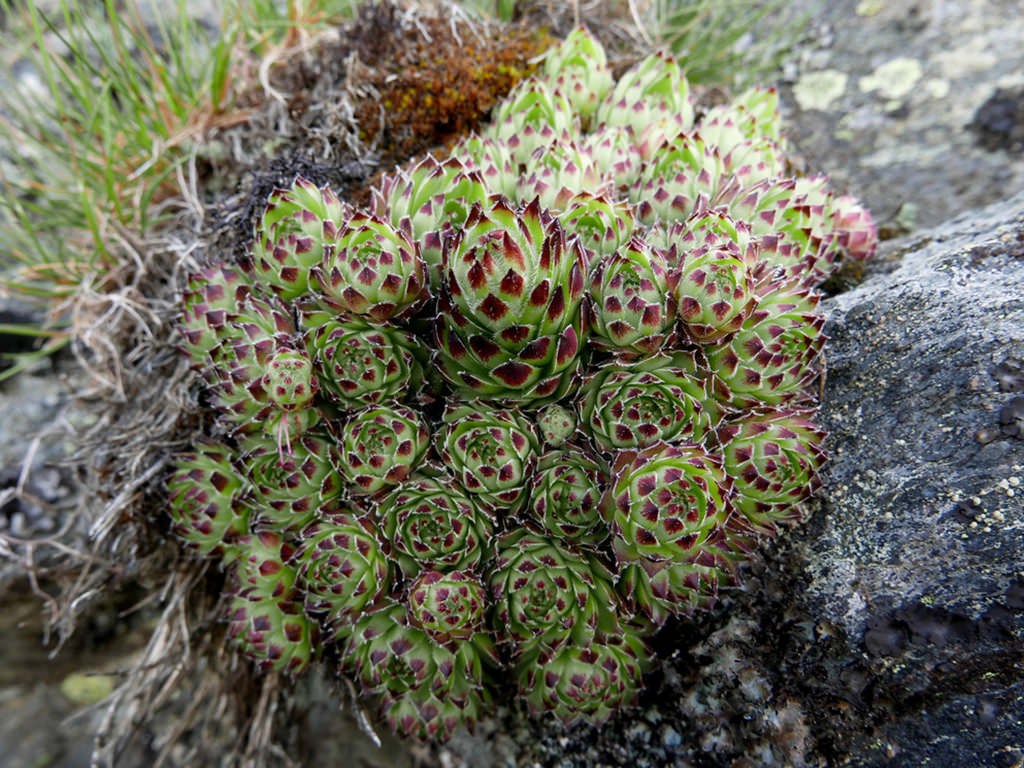Scientific Name
Sempervivum vicentei Pau
Synonym(s)
Sempervivum vicentei subsp. vicentei
Scientific Classification
Family: Crassulaceae
Subfamily: Sedoideae
Tribe: Sedeae
Subtribe: Sedinae
Genus: Sempervivum
Origin
This species is native to Spain and Portugal. It grows amongst rocks at elevations between 2,000 and 7,500 feet (600 and 2,300 m) in the Cantabrian Mountains and the mountains in the Central Iberian System.
Description
Sempervivum vicentei is a small succulent that forms a dense mat of stemless rosettes of juicy green leaves with a purple tip. The rosettes grow up to 3.6 inches (9 cm) in diameter. Leaves are glandular-hairy with conspicuous marginal cilia. They are lanceolate, up to 1.4 inches (3.5 cm) long, and up to 0.4 inches (1 cm) in diameter. Flowers are pink to purple, star-shaped, up to 1 inch (2.5 cm) across, and appear in clusters at the tip of erect, leafy, up to 13.6 inches (34 cm) tall stalk in summer. The rosette dies after flowering, but it is replaced by young rosettes that form on lateral runners. Fruits are clusters of many-seeded follicles.
Etymology
The specific epithet "vicentei (vih-SEN-tee-eye)" probably honors Vicente Cutanda y Jarauta (1804-1866), a Spanish botanist, director of the Royal Botanical Garden of Madrid, and professor of Organography and Plant Physiology at this same institution.

How to Grow and Care for Sempervivum vicentei
Light: This succulent prefers a spot in full sun but will appreciate some afternoon shade if planted in hot climates. It is not suitable for indoor growing because it usually does not get as much sunlight as it likes.
Soil: To ensure S. vicentei thrives, it needs a well-draining soil mix with 25 to 50 % sand, gravel, and perlite or pumice. If planting in a pot, a commercial soil mix for succulents should be sufficient to keep the roots dry and happy.
Temperature: S. vicentei is perfect for cold climates, as it can handle temperatures down to -30 °F (-34.4 °C). It is also heat-tolerant but prefers average summer temperatures between 65 and 75 °F (18 and 24 °C). USDA Plant Hardiness Zones 4a to 9b, -30 to 30 °F (-34.4 to -1.1 °C).
Watering: Water thoroughly during the spring and summer and allow the soil to dry out between watering. Reduce watering in the fall when S. vicentei enters dormancy. Mature rosettes planted in the ground can overwinter without receiving extra water from you. Plants in containers may need a little water to make it through winter. Never let water sit in the rosette or underneath the pot.
Fertilizing: This Sempervivum grows well without feeding, but it benefits from a controlled-release fertilizer at the beginning of the growing season. It can also be fertilized once a week with a diluted liquid solution.
Repotting: Plants in containers will benefit from being repotted. Repot as needed, preferably during the spring.
Propagation: S. vicentei can be grown by dividing the offsets produced each season. The best time to divide the offsets is spring or summer, once they are at least a quarter of the mother rosette's size.
Learn more at How to Grow and Care for Sempervivum.
Toxicity of Sempervivum vicentei
Sempervivums are not known to contain any toxic compounds. Therefore, S. vicentei is considered a safe plant to grow around pets and children.
Links
- Back to genus Sempervivum
- Succupedia: Browse succulents by Scientific Name, Common Name, Genus, Family, USDA Hardiness Zone, Origin, or cacti by Genus
Photo Gallery
Click on a photo to see a larger version.



